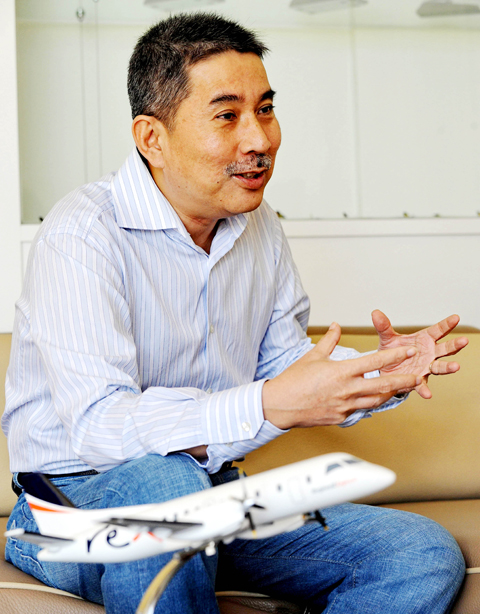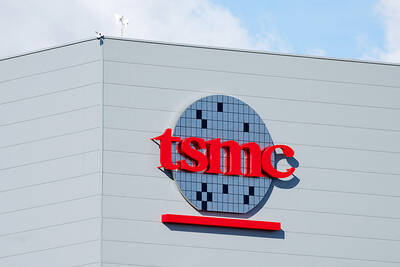Singaporean entrepreneur Lim Kim Hai is the first to admit that glamor and prestige did not even figure when he made the decision to invest in a regional Australian airline in 2002.
Seven years after Lim’s big gamble on Rex, the domestic carrier born out of the collapse of Ansett is turning healthy profits — despite the dismal state of the global aviation industry.
“Glamor doesn’t sell very many seats and glamor doesn’t produce profits,” he said in an interview in his Singapore office, from where he runs the airline’s headquarters in Sydney largely by remote control.

PHOTO: AFP
“If you are in it for the glamor, you will be in big trouble,” said Lim, an engineer by training who serves as the airline’s executive chairman.
Trouble was exactly the word to describe the state of Rex — short for Regional Express Holdings — which lost A$35 million (US$30 million) in its first year of operations in 2002 and needed a further capital injection to stay afloat, he said.
Lim and a Singaporean partner pumped another US$5 million to US$6 million into Rex, well aware of the odds stacked against them and the high probability of never seeing their money again.
Lim cannot reveal the amount he initially invested in Rex because of a confidentiality clause.
He says he is the biggest shareholder, with a stake of more than 20 percent in the publicly listed carrier.
In the first year of his tenure running Rex, Lim turned the loss-making carrier around, with a profit of US$1 million in the year to June 2004 as he initiated new practices to curb wastage and inefficiencies.
And Rex has never looked back, churning out profits every year through to the current fiscal period ended June, with profits down just 5.6 percent to US$23 million.
“Even though our profits were reduced, it’s quite comforting in this environment,” Lim said. “Obviously we know how severe the recession is ... So being able to overcome this year of really, really negative impact with relatively minor damage, I think it is quite satisfactory.”
Analyst Peter Harbison said Lim injected a new management style into Rex, making the carrier a rare success story in a country where the airline industry has had a list of notable failures.
“He applied a lot of business sense and he brought solid business discipline,” said Harbison of the Sydney-based Centre for Asia Pacific Aviation consultancy.
Even Lim concedes he did not give himself much of a chance in saving the carrier from the brink of collapse, but said giving up without even trying was not an option.
“The commonly accepted view at that time was the airline would last only six months,” said Lim, who will turn 52 next month.
“We knew the difficulties and the decision to carry on was not so much not knowing the facts but more of saying here is an airline that is losing money but it is operationally doing okay,” he said. “The airline was doing about 50,000 flights a year.”
With the second round of capital injection coming entirely from him and his Singaporean partner, Lee Thian Soo, 54, Lim decided it was time for a fresh perspective on how Rex should be managed.
The carrier has a fleet of 88 planes, comprising mainly SAAB 340 34-seaters, plying routes in southeast Australia, linking the country’s main cities to rural towns.
A one-way ticket is about US$130 on average, Lim said.
He says he makes just four trips a year to Sydney for the company’s board meetings and maintains that running Rex from his Singapore office does not put him at a disadvantage.
“I think with technology today, it’s very, very easy,” said Lim, who gets up to 300 emails daily from his key management staff.
If he had known everything he knows today, Lim admits, he probably would have had nothing to do with the industry.
“In hindsight, it was totally stupid and naive. We didn’t know how treacherous airlines were,” Lim said.

Taiwan Semiconductor Manufacturing Co (TSMC, 台積電) secured a record 70.2 percent share of the global foundry business in the second quarter, up from 67.6 percent the previous quarter, and continued widening its lead over second-placed Samsung Electronics Co, TrendForce Corp (集邦科技) said on Monday. TSMC posted US$30.24 billion in sales in the April-to-June period, up 18.5 percent from the previous quarter, driven by major smartphone customers entering their ramp-up cycle and robust demand for artificial intelligence chips, laptops and PCs, which boosted wafer shipments and average selling prices, TrendForce said in a report. Samsung’s sales also grew in the second quarter, up

LIMITED IMPACT: Investor confidence was likely sustained by its relatively small exposure to the Chinese market, as only less advanced chips are made in Nanjing Taiwan Semiconductor Manufacturing Co (TSMC, 台積電) saw its stock price close steady yesterday in a sign that the loss of the validated end user (VEU) status for its Nanjing, China, fab should have a mild impact on the world’s biggest contract chipmaker financially and technologically. Media reports about the waiver loss sent TSMC down 1.29 percent during the early trading session yesterday, but the stock soon regained strength and ended at NT$1,160, unchanged from Tuesday. Investors’ confidence in TSMC was likely built on its relatively small exposure to the Chinese market, as Chinese customers contributed about 9 percent to TSMC’s revenue last

With this year’s Semicon Taiwan trade show set to kick off on Wednesday, market attention has turned to the mass production of advanced packaging technologies and capacity expansion in Taiwan and the US. With traditional scaling reaching physical limits, heterogeneous integration and packaging technologies have emerged as key solutions. Surging demand for artificial intelligence (AI), high-performance computing (HPC) and high-bandwidth memory (HBM) chips has put technologies such as chip-on-wafer-on-substrate (CoWoS), integrated fan-out (InFO), system on integrated chips (SoIC), 3D IC and fan-out panel-level packaging (FOPLP) at the center of semiconductor innovation, making them a major focus at this year’s trade show, according

DEBUT: The trade show is to feature 17 national pavilions, a new high for the event, including from Canada, Costa Rica, Lithuania, Sweden and Vietnam for the first time The Semicon Taiwan trade show, which opens on Wednesday, is expected to see a new high in the number of exhibitors and visitors from around the world, said its organizer, SEMI, which has described the annual event as the “Olympics of the semiconductor industry.” SEMI, which represents companies in the electronics manufacturing and design supply chain, and touts the annual exhibition as the most influential semiconductor trade show in the world, said more than 1,200 enterprises from 56 countries are to showcase their innovations across more than 4,100 booths, and that the event could attract 100,000 visitors. This year’s event features 17